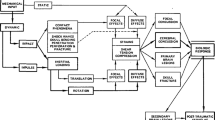Abstract
A powerful tool for investigating the physical process producing head trauma is finite element (FE) modeling. In this paper, we present a 3D FE model of the human head that accounts for important geometric characteristics of the various components within the human head through an efficient magnetic resonance imaging voxel-based mesh generation method. To validate the FE model, a previous cadaver experiment of frontal impact is simulated, and this is where heretofore unknown wave patterns are discovered. The model is run under either of two extreme assumptions concerning the head-neck junction—free or fixed—and the experimental measurements are well bounded by the computed pressures from the two boundary conditions. In both cases the impact gives rise to not only a fast pressure wave but also a slow and spherically convergent shear stress wave which is potentially more damaging to the brain tissue.
Similar content being viewed by others
References
Fung Y.C.: The application of biomechanics to the understanding of injury and healing. In: Nahum, A.M., Melvin, J.W. (eds) Accidental Injury—Biomechanics and Prevention, pp. 1–11. Springer-Verlag, New York (2002)
Hanaway, J., Roberts, M.P., Woolsey, T.A., Gado, M.H., Roberts, M.P.J.: The Brain Atlas: A Visual Guide to the Human Central Nervous System. Fitzgerald Science Press, Bethesda (1998)
Hargreaves, E.L.: Meninges, http://homepages.nyu.edu/~eh597/Meninges.htm (2006). Accessed 30 November 2009
Zhang, L., Yang, K.H., Dwarampudi, R., Omori, K., Li, T., Chang, K., Hardy, W.N., Khalil, T.B., King, A.I.: Recent advance in brain injury research: a new human head model development and validation. Stapp Car Crash J. 369–393 (2001)
Willinger R., Kang H.S., Diaw B.: Three-dimensional human head finite-element model validation against two experimental impacts. Ann. Biomed. Eng. 27, 403–410 (1999)
Kleiven S., von Holst H.: Consequences of head size following trauma to the human head. J. Biomech. 35, 153–160 (2001)
Horgan T.J., Gilchrist M.D.: Influence of FE model variability in predicting brain motion and intracranial pressure changes in head impact simulations. Int. J. Crashworthiness. 9, 401–418 (2004)
Gilchrist M.D., O’Donoghue D.: Simulation of the development of frontal head impact injury. Comp. Mech. 26, 229–235 (2000)
Cloots R.J.H., Gervaise H.M.T., van Dommelen J.A.W., Geers M.G.D.: Biomechanics of traumatic brain injury: influences of the morphologic heterogeneities of the cerebral cortex. Ann. Biomed. Eng. 36, 1203–1215 (2008)
Lauret C., Hrapko M., van Dommelen J.A.W., Peters G.W.M., Wismans J.S.H.M.: Optical characterization of acceleration-induced strain fields in inhomogeneous brain slices. Med. Eng. Phys. 31, 392–399 (2009)
Guldberg R.E., Hollister S.J., Charras G.T.: The accuracy of digital image-based finite element models. J. Biomech. Eng. 120, 289–295 (1998)
Jacobs C.R., Mandell J.A., Beaupre G.S.: A comparative study of automatic finite element mesh generation techniques in orthopaedic biomechanics. Bioeng. Conf. ASME BED. 24, 512–514 (1993)
Boyd S.K., Müller R.: Smooth surface meshing for automated finite element model generation from 3D image data. J. Biomech. 39, 1287–1295 (2006)
Taubin, G.: A signal processing approach to fair surface design. In: Proc. Siggraph’95 Conference, pp. 351–358 (1995)
Taubin, G.: Geometric signal processing on polygonal meshes. Eurographic: State of the Art Report (2000)
Khalil T.B., Hubbard R.P.: Parametric study of head response by finite element modeling. J. Biomech. 10, 119–132 (1977)
Turitto V., Slack S.M.: Blood and related fluids. In: Black, J., Hastings, G. (eds) Handbook of Biomaterial Properties, pp. 114–124. Chapman & Hall, New York (1998)
Prange M.T., Margulies S.S.: Regional, directional, and age-dependent properties of the brain undergoing large deformation. J. Biomech. Eng. 124, 244–252 (2002)
Zhang L., Yang K.H., King A.I.: A proposed injury threshold for mild traumatic brain injury. J. Biomech. Eng. 126, 226–236 (2004)
Nahum, A., Smith, R., Ward, C.: Intracranial pressure dynamics during head impact. In: Proc. 21st Stapp Car Crash Conf., pp. 339–366 (1977)
Claessens, M., Sauren, F., Wismans J.: Modeling of the human head under impact conditions: a parametric study. In: Proc. 41st Stapp Car Crash Conf., pp. 315–328 (1997)
Christensen R.M.: Theory of Viscoelasticity: An Introduction, p 194. Academic Press, New York (1982)
Graff K.F.: Wave Motion in Elastic Solids. Dover, New York (1991)
Helms G., Kallenberg K., Dechent P.: Contrast-driven approach to intracranial segmentation using a combination of a T2- and T1-weighted 3D MRI data sets. J. MRI. 24, 790–795 (2006)
Ostoja-Starzewski, M.: Microstructural Randomness and Scaling in Mechanics of Materials. Chapman & Hall/CRC Press Boca Roton, FL (2008)
Li J., Ostoja-Starzewski M.: Fractal solids, product measures and fractional wave equations. Proc. R. Soc. Lond. A 465, 2521–2536 (2009)
Bayly P.V., Ji S., Song S.K., Okamoto R.J., Massouros P., Genin G.M.: Measurement of strain in physical models of brain injury: a method based on HARP analysis of tagged magnetic resonance images (MRI). J. Biomech. Eng. 126, 1–6 (2004)
Author information
Authors and Affiliations
Corresponding author
Rights and permissions
About this article
Cite this article
Chen, Y., Ostoja-Starzewski, M. MRI-based finite element modeling of head trauma: spherically focusing shear waves. Acta Mech 213, 155–167 (2010). https://doi.org/10.1007/s00707-009-0274-0
Received:
Revised:
Published:
Issue Date:
DOI: https://doi.org/10.1007/s00707-009-0274-0




